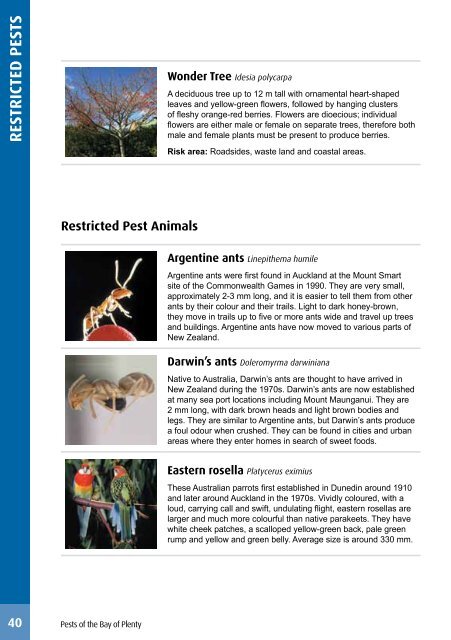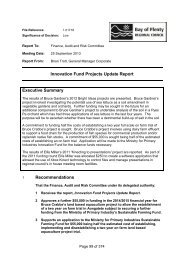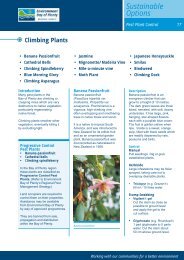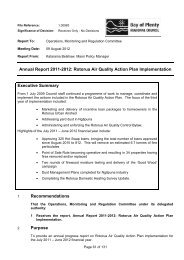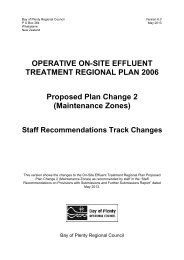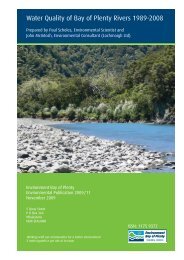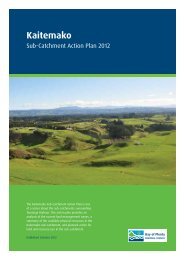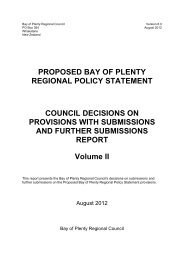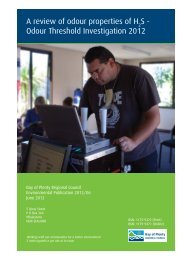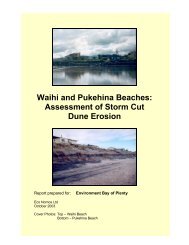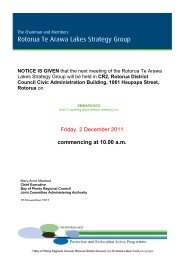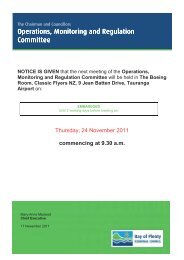Pests of the Bay of Plenty - Bay of Plenty Regional Council
Pests of the Bay of Plenty - Bay of Plenty Regional Council
Pests of the Bay of Plenty - Bay of Plenty Regional Council
- No tags were found...
Create successful ePaper yourself
Turn your PDF publications into a flip-book with our unique Google optimized e-Paper software.
RESTRICTED pestsWonder Tree Idesia polycarpaA deciduous tree up to 12 m tall with ornamental heart-shapedleaves and yellow-green flowers, followed by hanging clusters<strong>of</strong> fleshy orange-red berries. Flowers are dioecious; individualflowers are ei<strong>the</strong>r male or female on separate trees, <strong>the</strong>refore bothmale and female plants must be present to produce berries.Risk area: Roadsides, waste land and coastal areas.Restricted Pest AnimalsArgentine ants Linepi<strong>the</strong>ma humileArgentine ants were first found in Auckland at <strong>the</strong> Mount Smartsite <strong>of</strong> <strong>the</strong> Commonwealth Games in 1990. They are very small,approximately 2-3 mm long, and it is easier to tell <strong>the</strong>m from o<strong>the</strong>rants by <strong>the</strong>ir colour and <strong>the</strong>ir trails. Light to dark honey-brown,<strong>the</strong>y move in trails up to five or more ants wide and travel up treesand buildings. Argentine ants have now moved to various parts <strong>of</strong>New Zealand.Darwin’s ants Doleromyrma darwinianaNative to Australia, Darwin’s ants are thought to have arrived inNew Zealand during <strong>the</strong> 1970s. Darwin’s ants are now establishedat many sea port locations including Mount Maunganui. They are2 mm long, with dark brown heads and light brown bodies andlegs. They are similar to Argentine ants, but Darwin’s ants producea foul odour when crushed. They can be found in cities and urbanareas where <strong>the</strong>y enter homes in search <strong>of</strong> sweet foods.Eastern rosella Platycerus eximiusThese Australian parrots first established in Dunedin around 1910and later around Auckland in <strong>the</strong> 1970s. Vividly coloured, with aloud, carrying call and swift, undulating flight, eastern rosellas arelarger and much more colourful than native parakeets. They havewhite cheek patches, a scalloped yellow-green back, pale greenrump and yellow and green belly. Average size is around 330 mm.40<strong>Pests</strong> <strong>of</strong> <strong>the</strong> <strong>Bay</strong> <strong>of</strong> <strong>Plenty</strong>


